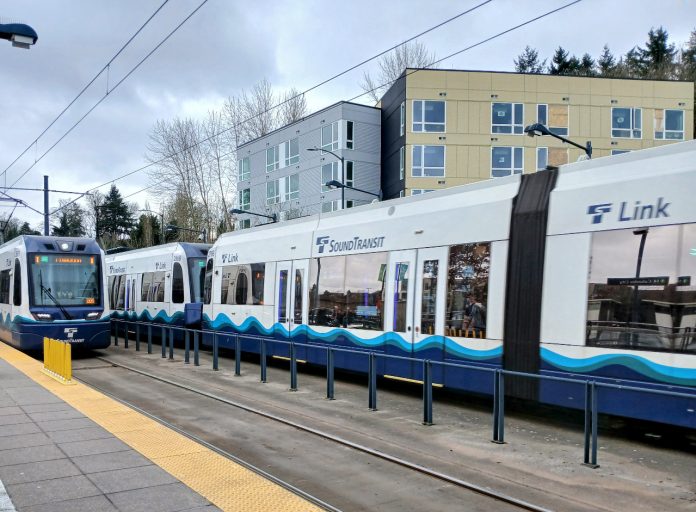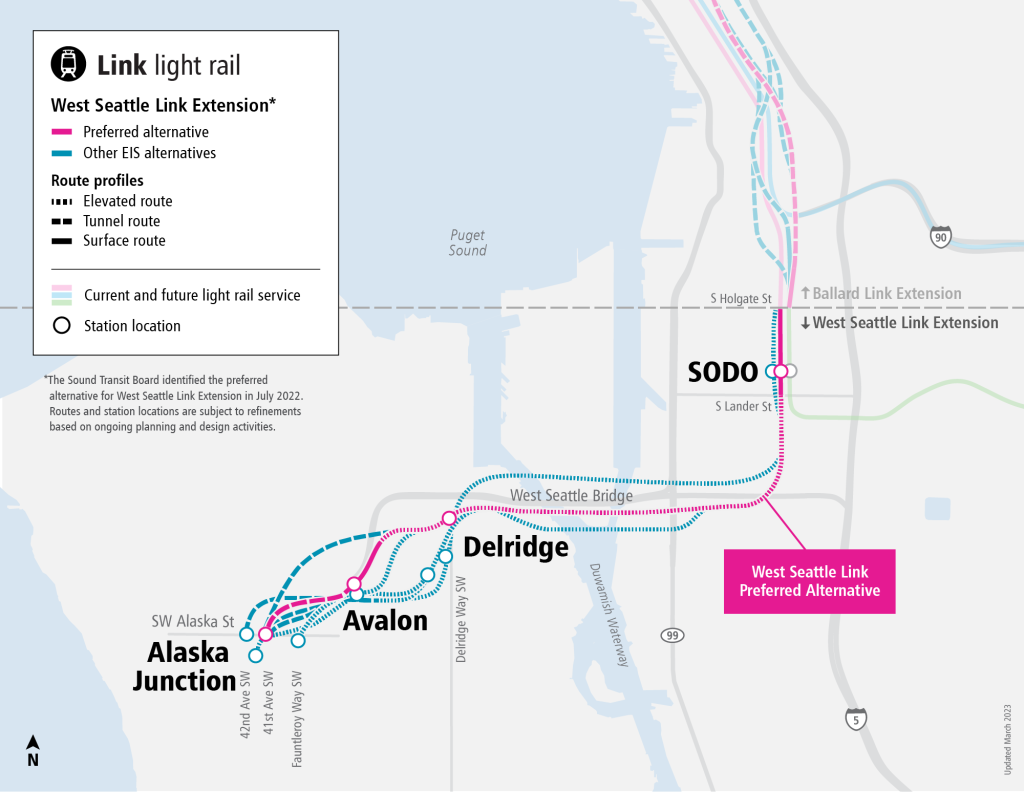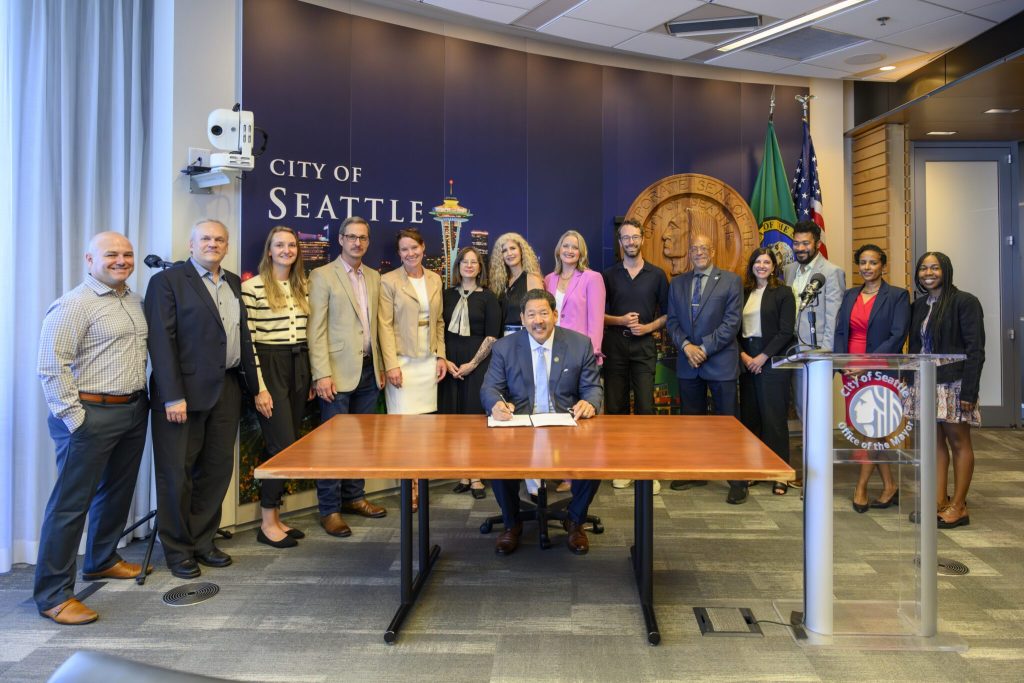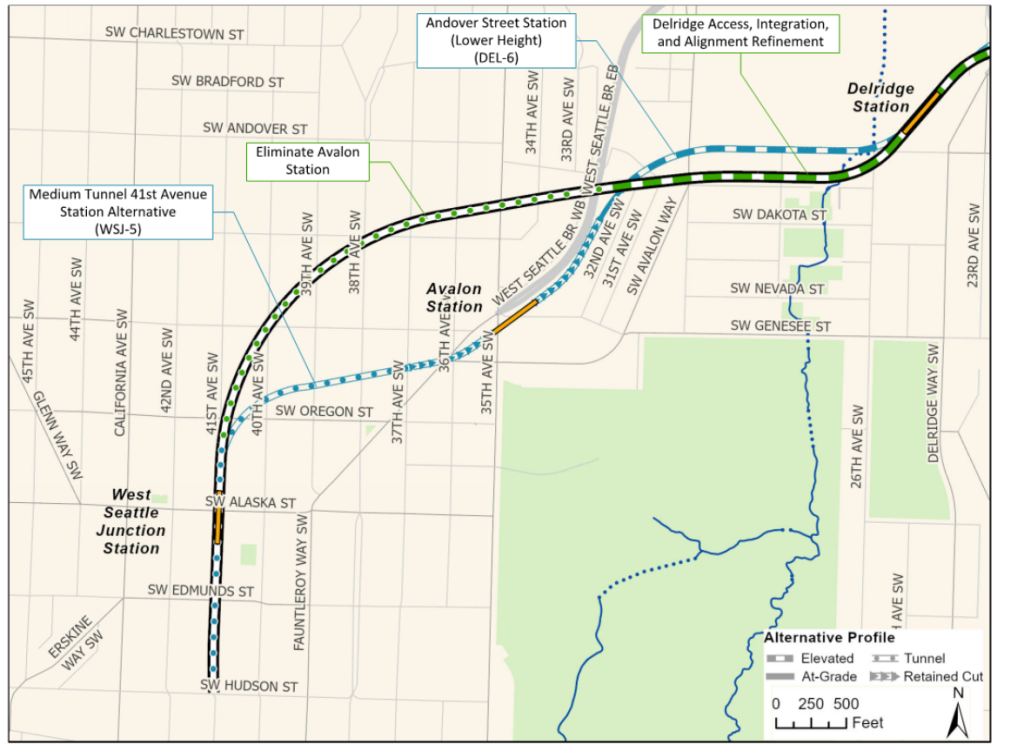
A pair of votes at the Seattle City Council next week will officially set the stage for a major milestone for the city’s coming light rail projects. Following approval of two pieces of legislation — updating a “transit way” agreement with Sound Transit and approving the most recent preferred guideway alignment and station locations — the City of Seattle will be ready to accept permits for the West Seattle Link Extension project, which will stretch from SoDo to Alaska Junction.
The first of two lines planned as part of the 2016 Sound Transit 3 (ST3) package in Seattle, West Seattle Link comes ahead of the larger and much more complex Ballard Link Extension, which will add a second light rail tunnel under Downtown Seattle.
The ordinance and resolution received unanimous support in the transportation committee early this month, and had been set to receive a final vote this week, but it was postponed one week in order to give city staff time to make technical amendments.
The vote will be a final step on the path to permit intake at the city level, expected to begin later this year. Some of those permits will help inform the project’s final design: later this month, the Sound Transit board will consider the latest round of property acquisitions along the West Seattle Link route, including a temporary easement on Harbor Island for testing of planned foundations for a future Duwamish Waterway bridge.

“First started with the Sound Transit Board taking action on the project to be built back in October of 2024, the Federal Transit Administration published a record of decision on that project in April of this year, and the final step in that three-agency process is Seattle City Council appending the project into the transit-way agreement by ordinance and adopting the project alignment and stations by resolution. Once those three steps are in place, then the city can start processing and issuing permits,” Sara Maxana, the City’s Sound Transit Program Director, told the council’s transportation committee last month.
The transit-way agreement has been in place since 2000, when permitting began on Sound Transit’s first light rail projects in the city. It gets updated every time another segment of the next moves forward. Prior to this week, it was last updated with the approval of an infill station at NE 130th Street — now called Pinehurst Station — in 2022. That station is set to open next year.
“The transit-way agreement is essentially the agreement under which the city grants Sound Transit the non-exclusive use of light rail transit way within the city’s right of way,” Maxana said. “Just as SDOT governs our streets and our roads as city right-of-way, the transit way is essentially where the alignment and stations exist, and the city is granting Sound Transit access to manage and operate the light rail system in that transit way.”

Modification of the transit-way agreement comes on the heels of a major overhaul of the city’s land use code and how it treats light rail lines, ceremonially signed into law by Mayor Bruce Harrell last week. The updates, which are expected to cut permit issuance timelines by around half, streamline requirements that were not initially meant to apply to projects of the size and scope of West Seattle Link and its even more ambitious counterpart, Ballard Link.
That code amendment package narrowly avoided being laden down with new community outreach requirements, proposed by Councilmember Maritza Rivera. Rivera’s initial changes would have required a brand new type of report for every permit application Sound Transit plans to submit to the city, likely adding hours of additional staff time at both the agency and city level. Following concerns raised by Alexis Mercedes Rinck and Dan Strauss — who is a Sound Transit board member — Rivera replaced her amendment with one that isn’t expected to create significant additional burdens.

Earlier this year, Mayor Bruce Harrell announced that the city’s Sound Transit 3 team would be merging with the city’s Office of the Waterfront, creating a new city department for light rail work that reports directly to the Mayor’s Office. That announcement followed an Executive Order aimed at expediting light rail construction issued in February, but the thing that will really keep ST3 projects moving are these code changes.
“The code amendments […] were probably the single greatest action that the city could take to expedite delivery of this of these projects, and did so in a way that also front-loaded the very important mitigation work that needs to happen to ensure that project impacts are mitigated,” Maxana said. “So we cut permit time in half by that, by those code amendments, so that’s one of the biggest things we could do.”
“With the legislation now approved, our team at the Seattle Department of Construction and Inspections [SDCI] is proud to move forward with streamlined permitting and refined light rail design standards—reflecting years of dedicated work and strong community input,” SDCI Director Nathan Torgelson, in his final days on the job before taking on a new role in Bellevue, said in a release timed with the bill’s signing. “These changes will deliver a more efficient process while preserving public engagement, coordinated tree and construction management, and robust bike and scooter parking at every station.”
With city approvals out of the way, both Sound Transit and the City’s ST3 team will be able to focus on advancing toward final design on West Seattle Link, though they will have to return to the city council many more times over the coming years on individual project elements. The transit-way agreement will then have to be updated again after the Record of Decision is issued for Ballard Link, expected in 2027.
The West Seattle Link Extension is currently trending around 75% more expensive than original cost estimates suggested, at $6.7-$7.1 billion. As the first major ST3 project to reach this level of design, West Seattle Link is likely just the tip of the iceberg when it comes to major cost increases that are likely to impact projects in all corners of the region.
In early June, Sound Transit CEO Dow Constantine revealed an agency-wide “enterprise initiative” that will seek to get the agency back onto financially sound footing, looking much more broadly for operational efficiencies than it has in the past.
Sound Transit’s capital delivery team, led by Deputy CEO Terri Mestas, is currently digging deep into project elements with the aim of finding cost savings — changes that would likely be able to be applied across other planned lines. The next update on those cost savings is expected by September. But scope changes for West Seattle remain on the table, including the potential elimination of the Avalon Station — a move that is only expected to save around $200 million.

While it’s taken nearly a full decade for West Seattle Link to go from voter approval to the first set of permit submissions, the milestone remains worth celebrating as Seattle heads toward additional expansion of its high capacity transit network. But choppy waters remain ahead.
Ryan Packer has been writing for The Urbanist since 2015, and currently reports full-time as Contributing Editor. Their beats are transportation, land use, public space, traffic safety, and obscure community meetings. Packer has also reported for other regional outlets including BikePortland, Seattle Met, and PubliCola. They live in the Capitol Hill neighborhood of Seattle.

